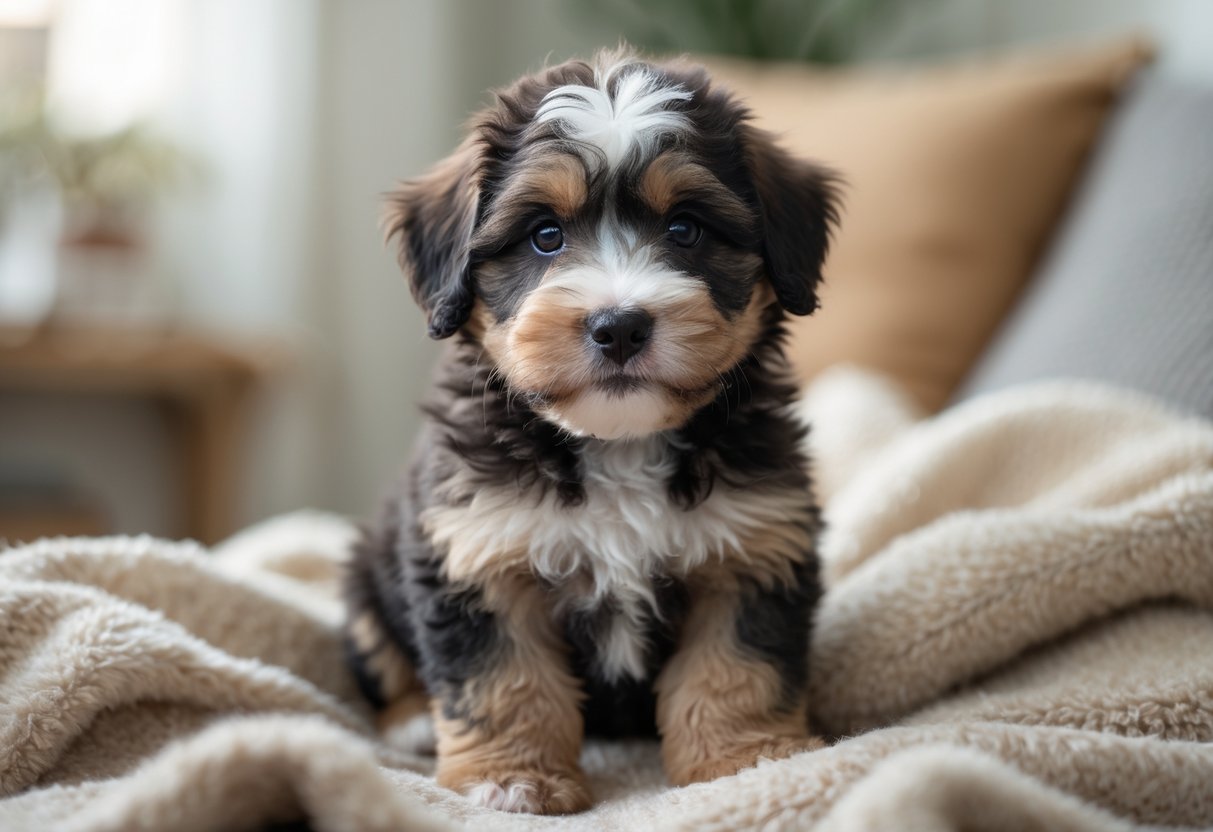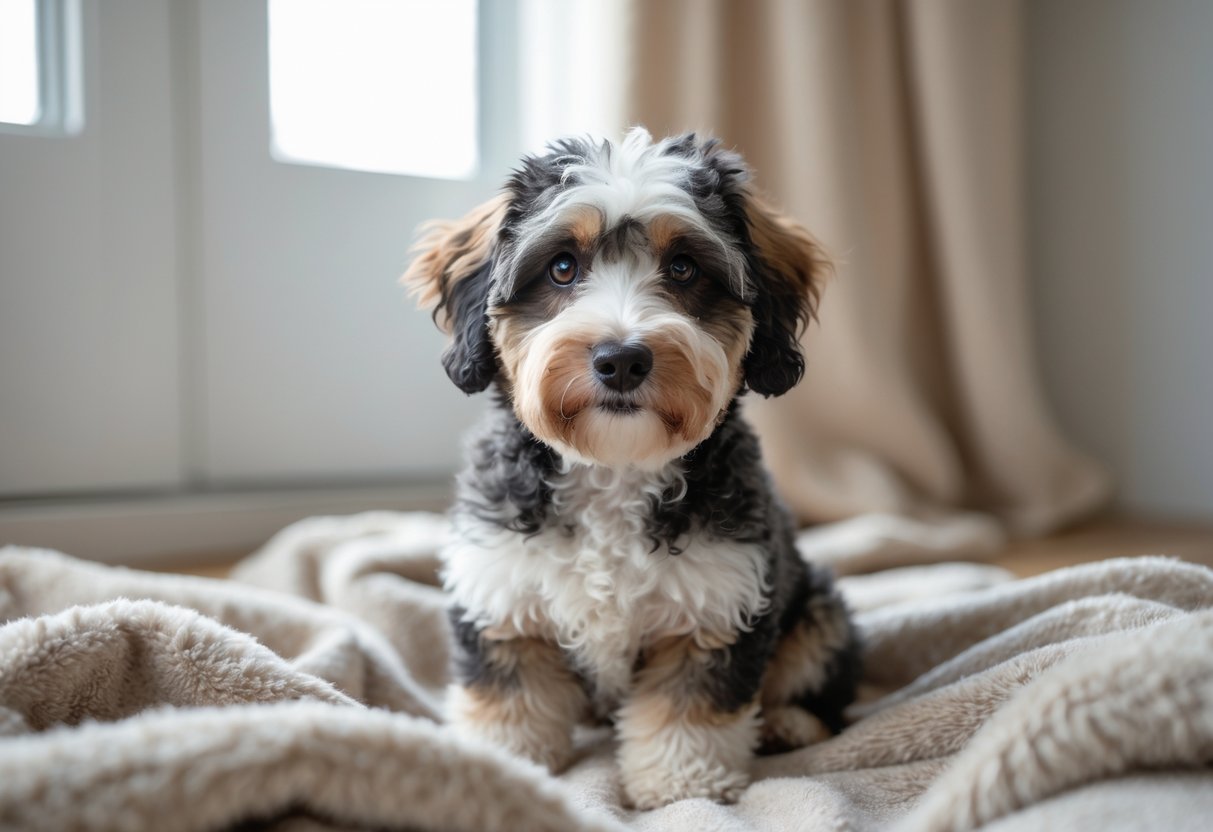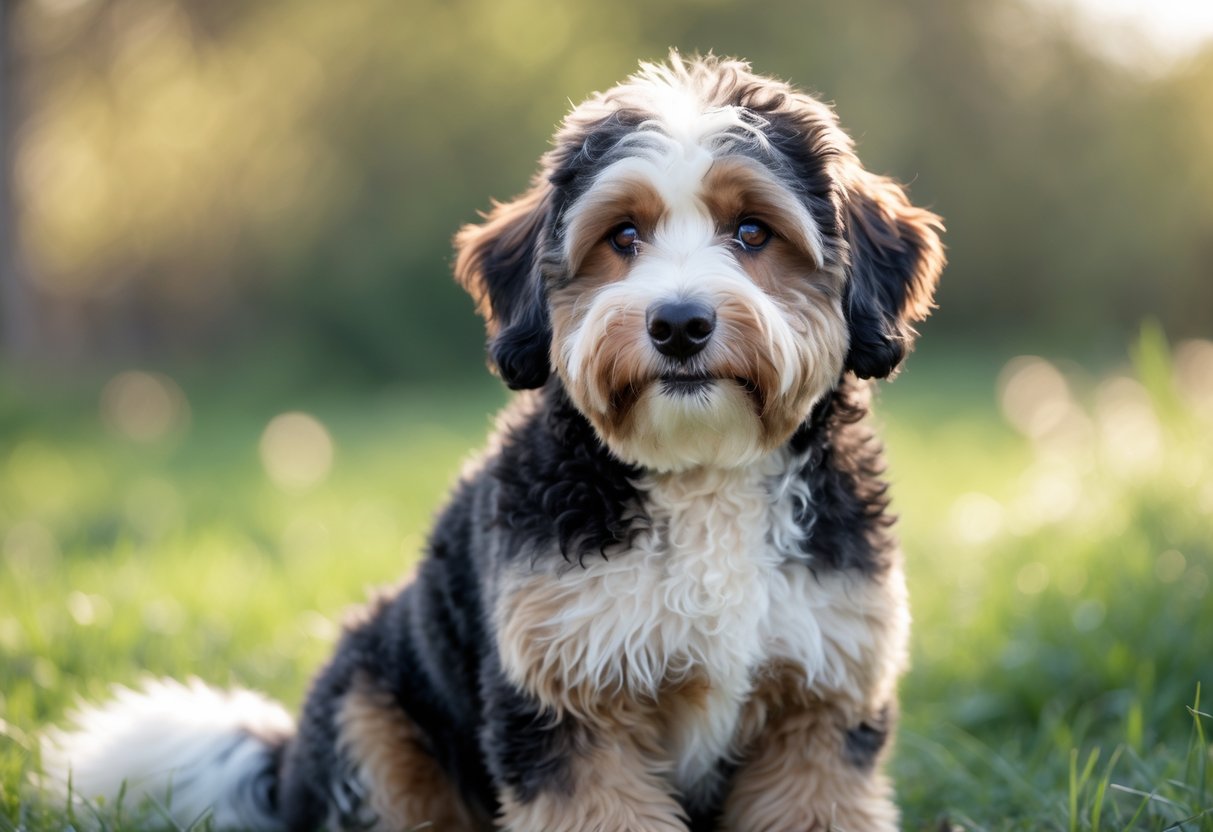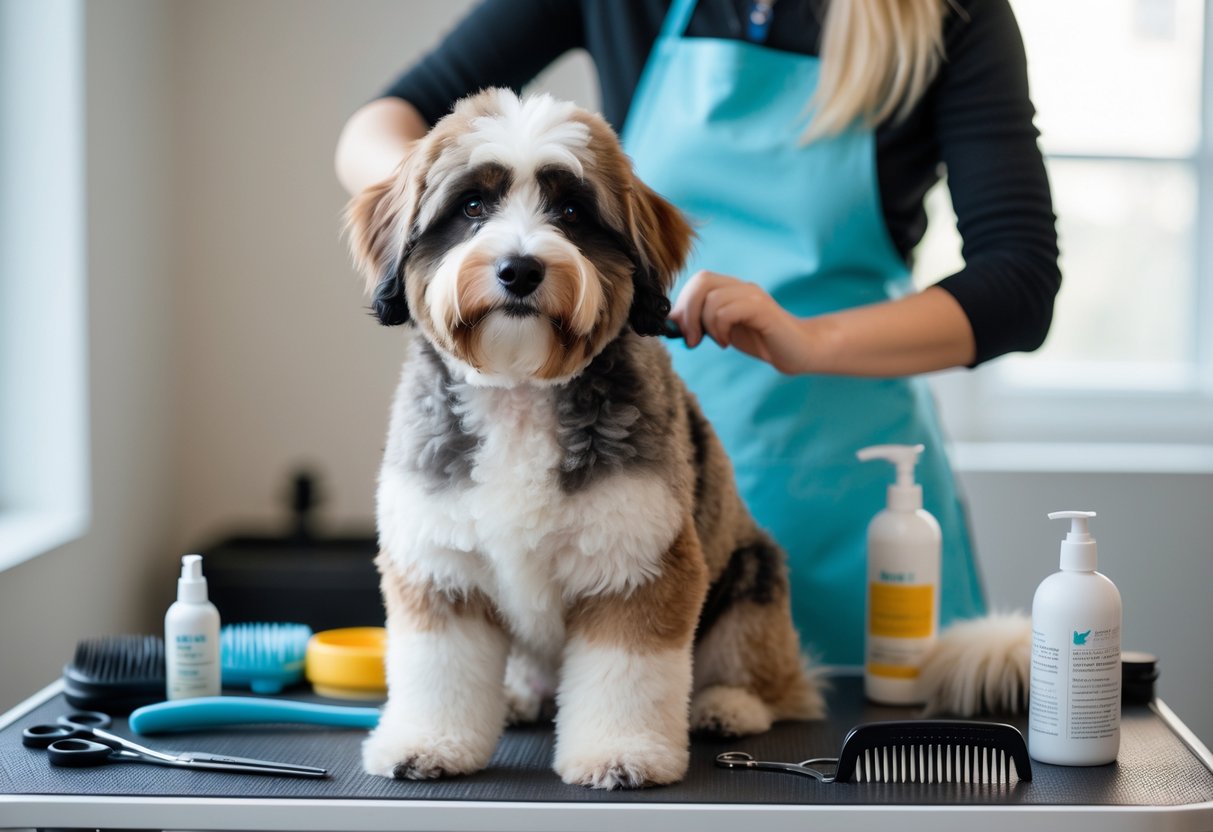Mini Bernedoodle Overview: Key Traits, Care, and Lifestyle Insights

The Mini Bernedoodle is a popular mix between the Bernese Mountain Dog and the miniature Poodle. It typically stands about 18 to 22 inches tall and weighs between 25 to 49 pounds, making it a smaller, more compact version of the standard Bernedoodle. This size makes it a good fit for people who live in smaller homes or have less space.
This breed is known for being intelligent and friendly, with a low-shedding coat that suits people with allergies. The Mini Bernedoodle’s combination of traits offers a balance of a playful, affectionate companion and a dog easier to care for in terms of grooming and size.
Because of its size and temperament, the Mini Bernedoodle adapts well to various living situations. It provides the benefits of a larger Bernese Mountain Dog but in a form that fits better in most households.
What Is a Mini Bernedoodle?

The Mini Bernedoodle is a smaller hybrid dog known for its friendly nature and smart behavior. It combines traits from both the Bernese Mountain Dog and the Miniature Poodle. Its size, looks, and personality set it apart from other similar breeds.
Origin and History
The Mini Bernedoodle is a cross between the Bernese Mountain Dog and the Miniature Poodle. This breed was created to blend the calm, gentle nature of the Bernese with the intelligence and low-shedding coat of the Poodle. Breeders aimed to make a smaller dog that fits well in homes that can’t accommodate a large dog.
This crossbreed started gaining popularity in the early 2000s as people looked for family-friendly pets that don’t shed much. It belongs to the group of designer dogs created by mixing two purebreds. Its history is shorter than many traditional breeds but reflects a mix of two distinct qualities.

Physical Characteristics
Mini Bernedoodles typically weigh between 25 to 49 pounds and stand about 18 to 22 inches tall. Their coat can be straight, wavy, or curly, usually low-shedding because of the Poodle influence.
They often have tri-color fur like the Bernese Mountain Dog, black, white, and brown, though some may have other color patterns. Their appearance combines the sturdy body shape of the Bernese with the softer features of the Poodle.
Their eyes are dark and expressive, and their ears hang down close to their heads. This blend creates a charming and approachable look.
Mini Bernedoodle vs. Standard Bernedoodle
The main difference between the Mini Bernedoodle and the Standard Bernedoodle is size. Standard Bernedoodles are larger, typically weighing 70 to 90 pounds and standing 23 to 29 inches tall.
Both dogs share a similar friendly temperament and intelligence. However, Mini Bernedoodles are easier to manage in smaller homes or apartments due to their size.
Their exercise needs are lower than the Standard. Both breeds shed less than the Bernese Mountain Dog, but coat types can vary. Choosing between them depends on how much space and care a person can provide.
Personality and Temperament

The Mini Bernedoodle is known for being loyal, friendly, and intelligent. Their personality fits well in family settings, with other pets, and shows a strong ability to learn and follow commands.
Behavior With Families
Mini Bernedoodles are gentle and affectionate with family members. They tend to bond closely with adults and children alike. These dogs are protective but not aggressive, making them suitable for homes with kids.
They enjoy playtime and responding to attention, which helps strengthen family connections. Their calm nature allows them to be good companions for quieter households as well. Consistent interaction is important to prevent boredom or separation anxiety. Overall, they thrive in environments where they receive regular love and care.
Interaction With Other Pets
This breed generally gets along well with other pets. They are social and can adjust to living with dogs, cats, or smaller animals if properly introduced. Early socialization helps reduce territorial behavior.
Because of their friendly disposition, Mini Bernedoodles rarely show aggression toward other animals. They often enjoy active play and exploration with pet companions. Monitoring playtime in the beginning is important to ensure smooth relationships. Their adaptable nature makes them a good choice for multi-pet homes.
Trainability
Mini Bernedoodles are smart and eager to learn. Their Poodle and Bernese Mountain Dog ancestry gives them high intelligence and a willingness to please. This makes training more straightforward compared to many other breeds.
They respond well to positive reinforcement methods like treats and praise. Consistency in commands and routines helps them progress faster. Their quick learning ability means they can master basic obedience and some advanced tricks, making them suitable for owners who want an active, engaged dog.
Care and Maintenance

The Mini Bernedoodle requires regular attention to grooming, exercise, diet, and health to stay happy and healthy. Proper care involves understanding their coat needs, activity levels, nutrition, and common health issues.
Grooming Needs
Mini Bernedoodles have curly or wavy coats that shed very little but need regular grooming. Brushing at least 2-3 times a week prevents mats and tangles. Professional grooming every 6-8 weeks keeps their coat neat and clean.
Their ears should be checked weekly to avoid infections. Regular teeth brushing and nail trimming are important parts of grooming. Bathing can be done once a month or when the dog looks dirty, using gentle dog shampoo.
Maintaining their coat not only keeps them comfortable but also reduces allergens in the home. Neglecting grooming can cause skin problems and discomfort.
Exercise Requirements
Mini Bernedoodles need moderate daily exercise to stay fit and happy. About 30 to 60 minutes of activity each day is ideal. This can include walks, playtime in the yard, or interactive games.
They enjoy mental stimulation like puzzle toys and training sessions, which prevent boredom. Without enough exercise, they may become restless or destructive.
Exercise also supports their joint health and keeps them at a healthy weight. Owners should adjust exercise based on the dog’s age and health.
Diet and Nutrition
A balanced diet with high-quality dog food is essential for Mini Bernedoodles. Their daily calorie needs vary with age, size, and activity level but typically range between 800 to 1,200 calories.
Their food should have good protein sources, healthy fats, and essential vitamins. Portion control helps prevent obesity, which can cause joint problems.
Fresh water must always be available. Avoid feeding human foods that are toxic to dogs, such as chocolate, onions, or grapes. Regular vet check-ups can help monitor their nutritional status.
Health Considerations
Mini Bernedoodles are generally healthy but can inherit issues from both parent breeds. Common concerns include hip dysplasia, elbow dysplasia, and certain eye conditions.
Routine veterinary care is important for early detection of problems. Vaccinations and parasite prevention keep them protected from infections.
Maintaining a healthy weight reduces stress on joints and lowers the risk of diabetes. Owners should watch for signs of discomfort or unusual behavior and seek vet advice when needed.
Choosing and Adopting a Mini Bernedoodle

Selecting a Mini Bernedoodle requires careful planning and attention to details like breeder reputation, adoption practices, and the expected costs involved. Understanding these elements helps ensure the dog’s health and well-being while fitting the owner’s lifestyle and budget.
Finding Responsible Breeders
A responsible breeder prioritizes the health and temperament of Mini Bernedoodles. They provide medical records, genetic testing, and a clean environment for the puppies. Visiting the breeder in person helps verify conditions and ask about the dog’s parents and socialization.
Beware of breeders who offer multiple litters at once or avoid showing the living space. A trustworthy breeder also supports new owners with advice on care and training. Avoid buying dogs from puppy mills or online ads without proper background.
Adoption Tips
Adopting a Mini Bernedoodle means considering the dog’s age, behavior, and medical history. Many shelters and rescue groups may have Bernedoodles or similar mixes available. It’s important to meet the dog and see how it interacts with the family or other pets.
Prepare questions about the dog’s past, energy level, and any special needs. Give the dog time to adjust and build trust before making a final commitment. Adoption can be a more affordable and ethical option than buying from breeders.
Cost of Ownership
Owning a Mini Bernedoodle involves initial expenses and ongoing costs. Initial costs include the adoption or purchase fee, vaccinations, spaying or neutering, and basic supplies like a bed and toys.
Recurring costs cover food, grooming, regular vet visits, and training classes. Grooming may be higher than average due to the dog’s coat type, which requires regular care to avoid mats and shedding. Owners should budget for emergencies and health issues too.
| Cost Type | Estimated Price Range |
|---|---|
| Adoption/Purchase | $1,000 – $3,000 |
| Vet Care (annual) | $200 – $500 |
| Grooming (every 6-8 weeks) | $50 – $100 per session |
| Food (monthly) | $40 – $70 |

Frequently Asked Questions
Mini Bernedoodles are known for their friendly nature and moderate size. Their growth, health, and personality depend on genetics and care. Understanding differences in breeding and potential challenges helps owners prepare better.
